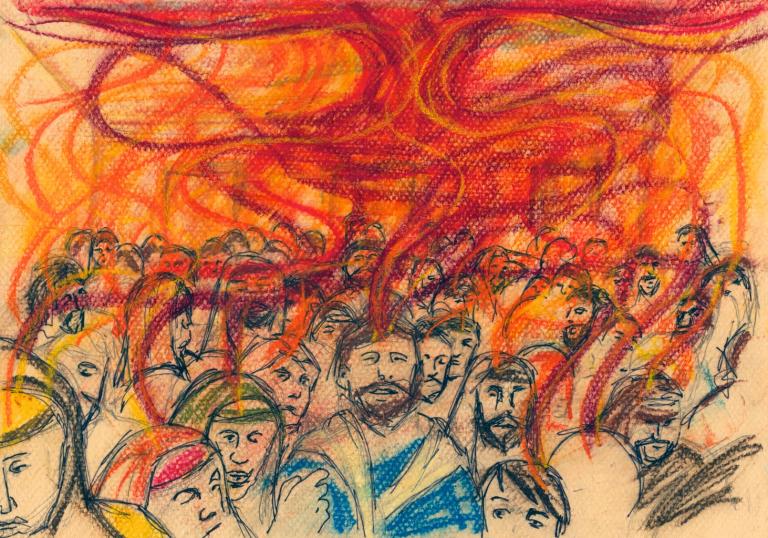Pentecost celebrates one of the high points in the Christian liturgical calendar, the coming of the Holy Spirt “as a mighty wind,” accompanied by tongues of fire and various miracles, that is commonly referred to as “the birth of the church.” For Christians, it arguably ranks just after Easter and Christmas in terms of historical markers of the divine’s interaction with humanity. But this year, Pentecost is different—as everything else has been different for the past many weeks.

When I lead my Living Stones discussion group in a Zoom seminar this afternoon, a group of friends from the Episcopal church I attend that has met monthly (now bi-weekly) for the past nine years, we will be talking about what the role that such high points play in one’s spiritual journey. What kind of nourishment is more important: Fast food or slow food?
When my sons were young, one of the most important distinctions in their estimation, when food was the issue, was “is it fast or slow food?” In other words, how much of my important schedule is this eating event going to take up? Fast food—McDonald’s, Wendy’s, or Burger King if going out; fish sticks, hot dogs, sandwiches if staying in—was obviously preferred. Slow food—any place where you have to sit down and wait if going out; anything involving more than five minutes of preparation time and that you would not be consuming in front of the television if eating in—was acceptable only if given sufficient warning. Going out to a slow food restaurant required preparation, including which coloring books to bring, psychological calming techniques, a consideration of the expected guest list, and so on.
The first slow food event that Jeanne and the boys ever attended together—Thanksgiving dinner 1987 with my parents and me at the Wort Hotel in Jackson, Wyoming—was such a slow food event that Jeanne finally walked into the kitchen to find out why the hell the food was taking so long. My sons were impressed that any human being would have the nerve to do such a thing.
They were not the only persons impressed that night, though. Jeanne still speaks on occasion about how remarkable it was that these two kids, eight and six, managed to keep themselves occupied without fidgeting or complaint for a much longer period of time than any human being should be required to wait for food. That’s only because they knew how to prepare.
When commencement exercises on my campus were cancelled two weeks ago due to Covid-19 concerns, I thought back to something the President of my college said to the graduating class a few years ago. In his greeting to the thousands of people gathered for Providence College commencement at the Dunkin’ Donuts Center, he gave one last reading assignment to the graduating seniors. “You must read Thinking, Fast and Slow by Daniel Kahneman,” Father Shanley said.
In this book, Kahneman distinguishes between two types of thinking that all of us come equipped with as human beings. Fast thinking, on the one hand, is the intuitive, almost unconscious way that we tend to make quick, snap judgments about events, people, choices, and even our life paths. Relying on emotion, memory, and hard-wired rules of thumb, much of our daily existence runs on fast thinking autopilot. Slow thinking, on the other hand, is much more deliberate, conscious, attentive, self-aware, and, well, slower. One of the book reviewers on Amazon’s site for this book writes that “The human mind is a hilariously muddled compromise between these incompatible modes of thought.”
The majority of us rely on fast thinking most of the time, even though we know that such thinking is often inaccurate and shot through with bias and prejudice. The question is, Why do we do it? At least on the surface, the answer clearly is “It’s easier.” Slow thinking laboriously checks the facts against the appearances, critically evaluates information, but is extraordinarily lazy and easily distracted.
Our slow thinking self is more than happy to turn things over to fast thinking simply because it conserves time and effort. Why take the time to consider the relevant details and nuances of a political candidate’s positions when it is so much quicker and easier to label her as a “conservative,” a “liberal,” a “socialist,” a “Trumper,” or a “never Trumper” and move on? Why expend the effort to actually get to know this new colleague or neighbor when it is much simpler to label him as “one of them” and go to lunch?
When the stakes are high, when one’s spiritual health and growth are the issue, the fast and slow distinction becomes far more than an interesting topic of conversation. Is the Christian life more like fast or slow food? Is it more like McDonald’s or Le Cirque? The Christian narrative is full of fast food events–Pentecost, Christmas, Easter–instant gratification events at the heart of belief that are so filling and satisfying that one could imagine that this is the exclusive food that fuels the life of faith. Each of us has had our own fast food, Big Bird moments, times when the veil between the mundane human and glorious divine is pierced, even for a moment, in some unforgettable way. What more does one need?
Plenty. Will Pentecost be enough to sustain those who experienced it when, weeks or months later, they are alone in chains awaiting torture or execution? Will your most spectacular Big Bird moment from the past be enough to get you through the stress of parenting, the tragedy of loss, a divorce, a lost job, an illness, the daily grind, or coronavirus seclusion?
If slow food is analogous to delayed gratification, then much—probably most—of the life of faith is slow food. Waiting, attending, struggling, just being, all the time wondering if you are ever going to get food again. That conversion experience, that healing, that moment that you vibrated with the presence of God are all distant memories. And one cannot eat memories.
Our fast thinking selves, applied to the spiritual life, may decide that an occasional trip to the McDonald’s of faith is good enough. A few milestones, both doctrinal and personal, become the sole sustenance of faith, bolstered by some quick and easy rules of thumb and prescribed ways of behaving. Go to church, say your prayers, maybe read your Bible on occasion. Our slow thinking selves are willing to concede that this has to be enough, because what else is there?
The answer lies in some of the food analogies that Jesus uses in the Gospels. “I am the bread of life,” he said. “He who believes in me shall never hunger.” “Whoever drinks the water I will give them will never be thirsty again,” he tells the Samaritan woman at the well. The message of Pentecost completes the Incarnation story—God, in the form of the Holy Spirit, is in us. The source of life, the food we need, is not in the fast food of events, of churches, nor is it in the slow food of waiting interminably for something to happen. It is in the regular, daily supply of nourishment that is in us “a well of water, springing up into everlasting life.”
Many of the hymns related to the Holy Spirit—“Spirit Divine, Attend Our Prayers,” “Come Holy Spirit, Heavenly Dove,” “Spirit of God, Descend Upon My Heart”– apparently are petitions for God to show up, to pay attention. But Big Bird hasn’t gone anywhere—she is in us all the time. These texts call us to attentiveness, to remembrance, to awareness that we have been provided with all the food we need. It’s just a matter of consuming it, because it is never used up. We don’t have to go shopping for the bread of life at either a fast or slow food establishment. It’s with us all the time.
Abraham Heschel once defined faith as “primarily faithfulness to a time when we had faith.” In He Held Radical Light, Christian Wiman comments further:
We remember these moments of heightened awareness in our lives, these clearings within consciousness in which faith is self-evidence and God too obvious and omnipresent to need that name, and we try to remain true to them.
Think of the best meal you ever had. Picture it, imagine the circumstances, the taste of the food, the company you were with. Chances are you are remembering a slow food event. Those are the eating events that, as my grandmother would have said, “stick to your ribs.” They also stick to your soul.












